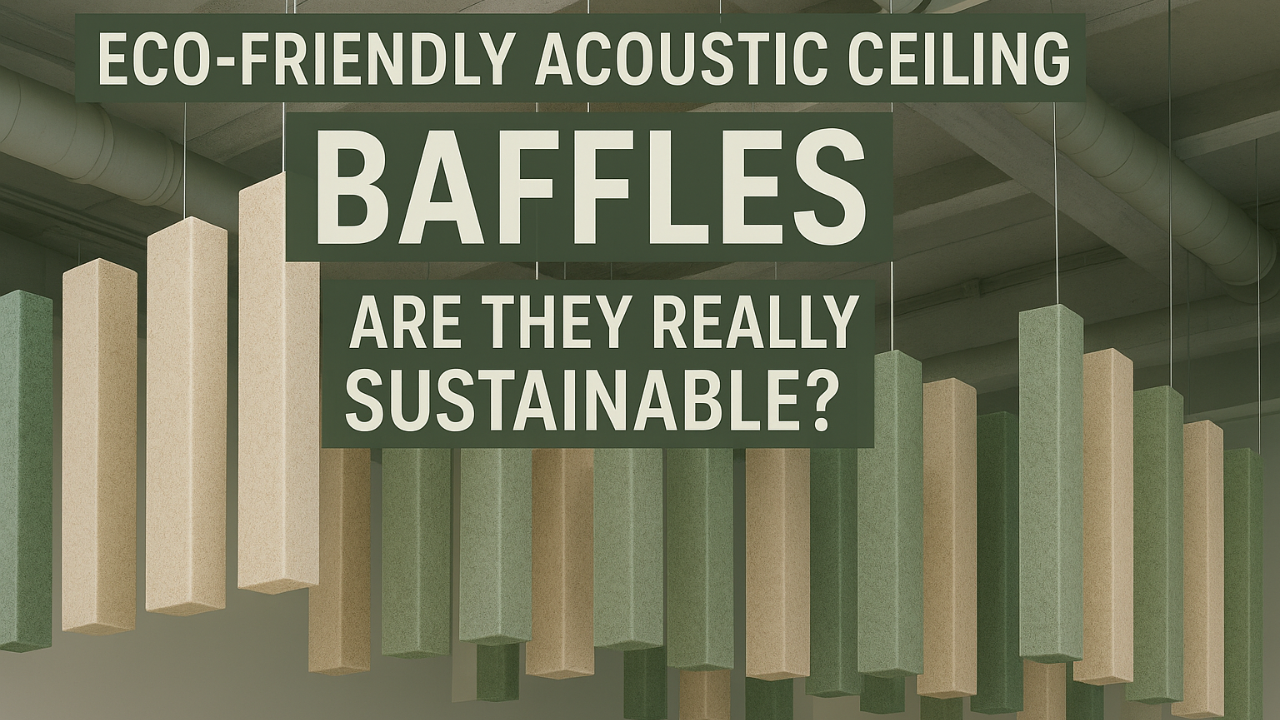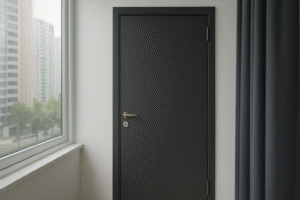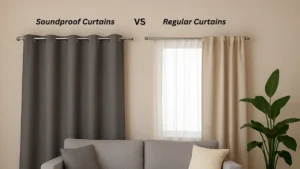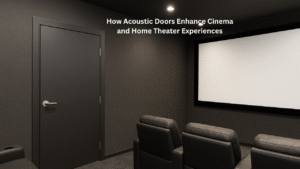A Deep Dive into the Materials, Performance, and Real-World Impact of “Green” Acoustic Baffles
In the modern building landscape, sustainability is no longer an optional design feature; it is an operational necessity. As architects and facility managers pursue LEED certification, ESG goals, and carbon-neutral operations, every material used in a project comes under scrutiny. Among these, acoustic ceiling baffles, once chosen purely for their sound absorption properties, are now being evaluated for their environmental footprint.
But are eco-friendly acoustic ceiling baffles truly sustainable, or are they simply part of another greenwashing trend? Let’s explore how these acoustic solutions are made, how they perform, and what makes them a genuinely sustainable choice for today’s commercial and institutional spaces.
What Are Eco-Friendly Acoustic Ceiling Baffles?
Acoustic baffles are vertically suspended sound-absorbing panels that reduce echo and reverberation in large, open spaces. Unlike wall-mounted acoustic panels, baffles are designed to hang from ceilings, making them ideal for areas with exposed infrastructure or high ceilings, such as offices, gyms, manufacturing units, and educational institutions.
Eco-friendly acoustic baffles are constructed using sustainable or recycled materials that minimize environmental impact. Common materials include:
- Recycled PET felt made from post-consumer plastic bottles
- Natural fibers such as hemp, wool, or cellulose
- Wood wool, a mix of wood fibers and cement
- Bio-based acoustic foams with low VOC emissions
These alternatives deliver excellent acoustic performance while reducing dependency on virgin plastics and minimizing waste.
Why Sustainability Matters in Acoustic Design
The conversation around sustainable building design has evolved far beyond energy efficiency. Today, acoustic comfort is recognized as a crucial component of occupant well-being, productivity, and overall environmental quality.
Traditional acoustic materials, often made from fiberglass, polyurethane foam, or PVC, tend to have significant environmental drawbacks. They are difficult to recycle, generate high emissions during manufacturing, and can release volatile organic compounds (VOCs) into the indoor air.
By contrast, eco-friendly acoustic baffles align with sustainable design frameworks such as:
- LEED (Leadership in Energy and Environmental Design)
- WELL Building Standard
- BREEAM (Building Research Establishment Environmental Assessment Method)
They help architects and builders meet indoor environmental quality (IEQ) and material optimization credits while supporting long-term sustainability goals.
How Eco-Friendly Acoustic Ceiling Baffles Work
At their core, Sound Baffles function by absorbing sound waves that would otherwise reflect off hard surfaces like concrete, glass, or metal. This reduces echo, enhances speech intelligibility, and creates a balanced acoustic environment.
The Science of Sound Absorption
Sound baffles work through porous absorption. When sound waves enter the material, friction converts the sound energy into heat, effectively dampening noise levels. The efficiency of this process is measured by the Noise Reduction Coefficient (NRC). High-performance baffles typically achieve an NRC between 0.75 and 1.00.
Material Influence on Performance
Eco-friendly materials perform exceptionally well in this regard. Recycled PET felt and wood wool, for example, offer high absorption across a wide frequency range while being lighter, safer, and easier to handle than traditional materials.
Energy Efficiency Benefits
By improving acoustic balance, these baffles can also enhance HVAC efficiency, as less background noise allows systems to operate at lower speeds without compromising comfort. This creates a dual sustainability impact: better energy use and improved occupant comfort.
Are Acoustic Ceiling Baffles Truly Sustainable?
The sustainability of any building material depends on several factors throughout its lifecycle, from raw material sourcing to disposal.
1. Material Source and Composition
Eco-friendly baffles use recycled, renewable, or low-impact materials. For example:
- Recycled PET baffles repurpose single-use plastics into long-lasting building materials.
- Wood wool panels combine natural wood fibers with cement, providing durability and fire resistance without synthetic binders.
- Natural fibers such as jute or hemp are biodegradable and renewable.
2. Manufacturing Process
Sustainable manufacturing focuses on minimizing emissions, reducing energy consumption, and optimizing waste recovery. Many leading manufacturers now operate closed-loop systems that recycle production waste back into new products.
3. Indoor Air Quality
A major sustainability factor often overlooked is indoor air quality (IAQ). Many eco-friendly acoustic materials are low-VOC and formaldehyde-free, which helps maintain healthy air conditions in occupied buildings, essential for WELL and LEED certifications.
4. Recyclability and End-of-Life
True sustainability doesn’t end with installation. Eco-friendly baffles can often be recycled or repurposed after their service life, unlike traditional fiberglass panels that typically end up in landfills.
Environmental Benefits of Eco-Friendly Acoustic Baffles
When compared to conventional soundproofing materials, sustainable acoustic ceiling baffles deliver a wide range of environmental and operational advantages.
- Lower carbon footprint due to recycled or bio-based materials
- Recyclability that supports circular economy principles
- Non-toxic and low-emission compositions for better IAQ
- Durability and long-term performance with minimal maintenance
- Contribution to LEED, WELL, and BREEAM credits
Design and Aesthetic Advantages
Eco-friendly doesn’t mean plain. Modern acoustic baffles are engineered for both performance and design versatility.
They come in a wide range of shapes, colors, and finishes, allowing architects to create visually striking ceilings that complement the overall interior design. From linear installations in corporate offices to geometric patterns in educational institutions, sustainable baffles enable functional creativity.
Integration with Modern Design Trends
- Exposed ceiling designs: Baffles enhance open, industrial-style interiors.
- Biophilic design: Wood wool and natural fiber baffles pair beautifully with greenery and natural finishes.
- Custom branding: Recycled PET panels can be laser-cut, printed, or color-matched for unique aesthetic requirements.
This fusion of form and function makes them ideal for architects aiming to meet acoustic, aesthetic, and environmental objectives simultaneously.
Cost and Longevity Considerations
One common misconception is that sustainable acoustic products are inherently more expensive. While initial costs may be slightly higher, the long-term return on investment often outweighs the difference.
Lifecycle Cost Efficiency
Eco-friendly materials are designed for durability. Many PET and wood wool baffles maintain their structure and acoustic performance for over a decade with minimal upkeep.
Reduced Maintenance
Unlike traditional materials that can degrade, shed fibers, or discolor over time, sustainable baffles resist moisture, dust, and microbial growth. This leads to lower maintenance costs and longer replacement cycles.
Value in Green Buildings
For developers and facility owners, integrating eco-friendly baffles contributes to property value appreciation, occupant satisfaction, and brand reputation, especially in sectors that emphasize ESG compliance.
Choosing the Right Eco-Friendly Acoustic Baffles
Selecting the right sustainable acoustic solution requires balancing performance, aesthetics, and environmental credentials.
Key Factors to Consider
- Material Composition: Verify recycled or renewable content.
- NRC Rating: Ensure sufficient absorption for the room’s size and function.
- Fire and Safety Ratings: Choose Class A fire-rated materials.
- Certifications: Look for LEED, WELL, or Greenguard compliance.
- Installation Flexibility: Confirm compatibility with existing ceiling systems.
Where to Use Eco-Friendly Baffles
- Corporate Offices: Improve focus and speech clarity.
- Educational Spaces: Enhance learning environments.
- Hospitality and Retail: Create comfortable customer experiences.
- Industrial Facilities: Reduce machine noise and echo.
Partnering with a specialized acoustic consultant or manufacturer ensures optimal results both acoustically and environmentally.
Explore Sustainable Acoustic Solutions
At Ecotone Systems, we specialize in eco-friendly acoustic products that combine sound performance, sustainability, and aesthetics. From recycled PET ceiling baffles to wood wool wall panels, our solutions help architects and builders design greener, quieter, and more productive environments.
Our Offerings Include
- Eco-friendly ceiling baffles and clouds
- Wall-mounted acoustic panels
- Modular sound absorption systems
- Custom acoustic design solutions
Whether you are designing a new space or upgrading an existing facility, our team can help you integrate sustainable acoustics into your project without compromising performance.
Let’s Build a Quieter, Greener Future
Ready to explore eco-friendly acoustic solutions for your next project?
Contact us today. We are here to help you design for sound, sustainability, and success.
Acoustic baffles are ceiling-mounted sound-absorbing panels designed to control noise and improve sound clarity in interior spaces. These panels are suspended vertically from the ceiling, allowing them to absorb sound waves from multiple directions. This helps minimize echo, reduce background noise, and enhance speech intelligibility — making them ideal for offices, schools, restaurants, and auditoriums.
Acoustic ceiling baffles are not only cost-effective but also aesthetically pleasing, offering a clean, modern look that complements various interior designs.
Yes, acoustic ceiling baffles are highly effective at improving sound quality. By hanging vertically, they capture and absorb reflected sound waves, significantly reducing reverberation in large or open areas. This results in clearer communication, better focus, and a more comfortable acoustic environment. They are especially beneficial in open-plan offices, gyms, call centers, and public buildings where sound control is essential.
In acoustics, a baffle refers to a panel or structure designed to absorb, block, or redirect sound waves. Acoustic ceiling baffles specifically target sound reflections from ceilings — one of the main sources of echo in large spaces. By interrupting the path of sound waves, baffles help create a more balanced and pleasant sound environment, improving both comfort and performance in noise-sensitive settings.





